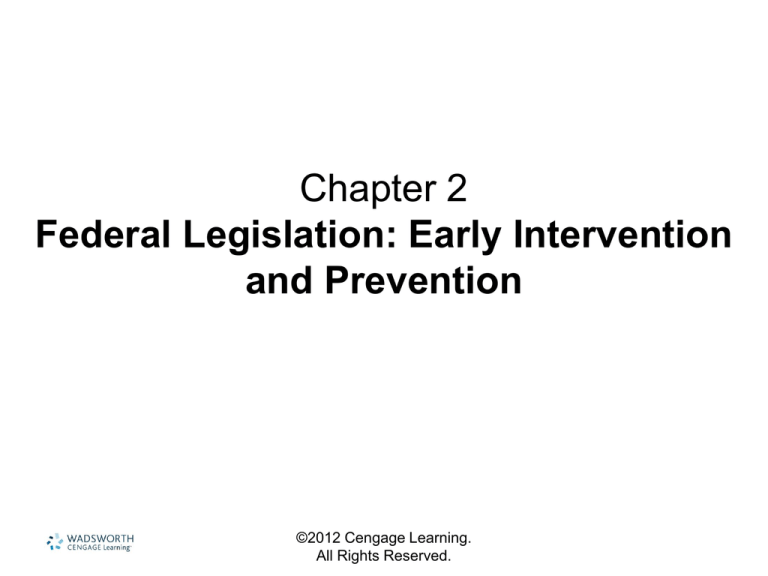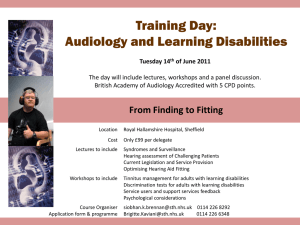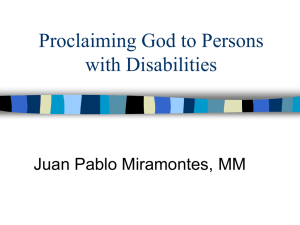
Chapter 2
Federal Legislation: Early Intervention
and Prevention
©2012 Cengage Learning.
All Rights Reserved.
The Early Intervention Movement
• Environment and experience
– The belief that children are what they are has
been challenged.
– Environment can affect how a child grows and
develops.
– Brain research leads us to understand that
children need experiences often and early to
develop needed synapses.
©2012 Cengage Learning.
All Rights Reserved.
The Early Intervention Movement
(continued)
• Civil rights
– People with disabilities have the same rights
as everyone else.
– They have a right to a free, appropriate, and
equal education.
– Landmark legislation passed, and is
continuing to pass, exercising all individuals’
constitutional rights.
©2012 Cengage Learning.
All Rights Reserved.
Public Policy and the Gifted
• All fifty states have definitions for
giftedness.
• Federal funds are not allocated for gifted
programs.
• States have taken it upon themselves to
provide services to children who
demonstrate giftedness.
• Educators continue to try to identify young,
gifted children.
©2012 Cengage Learning.
All Rights Reserved.
Landmark Legislation and People with
Disabilities
• University Centers of Excellence in 2000
(PL 106-402)
• Their main purposes are the following:
• To create, demonstrate, and evaluate intervention and
educational programs for children and youth with disabilities
and their families
• To provide professional trainees with interdisciplinary training
• To conduct research related to human development and
developmental problems
• To establish university-community partnerships to improve
services for people with disabilities
©2012 Cengage Learning.
All Rights Reserved.
Landmark Legislation and People with
Disabilities (continued)
• Handicapped Children’s Early Education
Assistance Act (PL 90–538)
– The major purpose of this legislation is to
improve early intervention services for
children with disabilities, children who are
at-risk for disabilities, and their families.
– Federal funds supported experimental centers
known as the First Chance Network and
model demonstration projects.
©2012 Cengage Learning.
All Rights Reserved.
Landmark Legislation and People with
Disabilities (continued)
• Head Start amendments (PL 92–424)
– Mandated (required) that 10 percent of Head
Start’s enrollment be reserved for children
with developmental disabilities
©2012 Cengage Learning.
All Rights Reserved.
Landmark Legislation and People with
Disabilities (continued)
• Head Start continues to grow
– Early Head Start
• serves low-income women and their very young
children
• is designed around four cornerstones: child
development, family development, community
development, and staff development
©2012 Cengage Learning.
All Rights Reserved.
Landmark Legislation and People with
Disabilities (continued)
• Head Start continues to grow
– Disability services quality improvement
centers
• There are 12 in the United States.
• They provide information, personnel training,
services, and equipment in collaboration with
various agencies.
©2012 Cengage Learning.
All Rights Reserved.
Landmark Legislation and People with
Disabilities (continued)
• Developmental Disabilities Act (DDA) (PL
106–402)
– Section 504 focused on reducing discrimination
against individuals with disabilities.
– The law required that everyone with a disability be
given access to jobs, education, housing, and public
buildings.
– This law also requires schools to make
accommodations for children who have disabilities but
do not qualify for special education.
©2012 Cengage Learning.
All Rights Reserved.
Landmark Legislation and People with
Disabilities (continued)
• Education of All Handicapped Children Act
(PL 94–142)
– Now called the Individuals with Disabilities
Education Act (IDEA)
– Guarantees all children a free, appropriate,
public education
– Encourages states to locate and serve
preschool children needing early intervention
services
©2012 Cengage Learning.
All Rights Reserved.
Landmark Legislation and People with
Disabilities (continued)
– IDEA mandates
• Zero reject
– Local school systems must provide all children,
regardless of the severity of their disability, with a free
education appropriate to each child’s needs.
• Non-discriminatory evaluation
– Tests must be appropriate to the child’s language and
cultural background.
– Assessment is to be based on several types of
evaluation and is to include cognitive, adaptive, and
social performance.
©2012 Cengage Learning.
All Rights Reserved.
Landmark Legislation and People with
Disabilities (continued)
– IDEA mandates
• Appropriate education
– Local school districts must provide educational services
that are appropriate to each individual child.
• Least restrictive environment (Inclusion)
– Children with disabilities must be educated alongside
students who do not have identified disabilities.
• Due process
– Parents must have the right to call a special hearing
when they do not agree with the school’s educational
plans for their child.
©2012 Cengage Learning.
All Rights Reserved.
Landmark Legislation and People with
Disabilities (continued)
– IDEA mandates
• Parent participation
– States must provide mediation to schools and parents if
there are disagreements about children’s educational
services.
©2012 Cengage Learning.
All Rights Reserved.
Landmark Legislation and People with
Disabilities (continued)
• Education of the Handicapped amendments
(PL 99–457)
– Services for children birth to age 3
• This part of the law is known as discretionary
legislation.
• This means that a state may serve children from
birth through two years of age if it chooses, but it is
not required by law to do so.
©2012 Cengage Learning.
All Rights Reserved.
Landmark Legislation and People with
Disabilities (continued)
• Education of the Handicapped amendments
(PL 99–457)
– Services for children birth to age 3
• Those to be served are infants and toddlers who
are experiencing developmental disabilities or are
at-risk of having substantial delays unless they
receive early intervention services.
• Labeling is no longer required .
• Individualized family service plan (IFSP):
multidisciplinary, written assessment of their
needs and of the services prescribed.
©2012 Cengage Learning.
All Rights Reserved.
Landmark Legislation and People with
Disabilities (continued)
• Education of the Handicapped amendments
(PL 99–457)
– Services for children ages 3 to 5
• Services for children beginning at age three are
not discretionary.
• States receiving federal funds for early intervention
programs must serve young children with
developmental disabilities according to the same
formula and requirements as before.
©2012 Cengage Learning.
All Rights Reserved.
Landmark Legislation and People with
Disabilities (continued)
• Latest updates on IDEA
– The new definition requires special education
teachers to hold at least a B.A., obtain full state
special education licensure or equivalent, and cannot
hold a temporary or emergency licensure.
– Extensive provisions are aimed at ensuring special
education and related services for children with
disabilities who are homeless or otherwise members
of highly mobile populations.
– The addition of a resolution session prior to a due
process hearing to encourage the parties resolve their
dispute—within 15 days of the parent’s complaint.
©2012 Cengage Learning.
All Rights Reserved.
Landmark Legislation and People with
Disabilities (continued)
• Latest updates on IDEA (continued)
– Functional behavioral assessment
– Children with disabilities who have been expelled
from school still have the right to an education, and
the state must guarantee that services are still
provided throughout the expulsion.
– Authority to extend Part C services for infants and
toddler services beyond the age of two years.
– Short-term objectives and benchmarks are no longer
required sections in the IEP.
©2012 Cengage Learning.
All Rights Reserved.
Landmark Legislation and People with
Disabilities (continued)
• Discipline issues
– A student with a disability generally cannot be
suspended from school for more than 10 school days
if the misconduct was related to his or her disability
and services still need to be provided.
– The IEP team, including parents, must conduct a
functional behavior assessment and consider
strategies including positive behavioral support
strategies to facilitate appropriate behavior in the
classroom.
©2012 Cengage Learning.
All Rights Reserved.
Landmark Legislation and People with
Disabilities (continued)
• Americans with Disabilities Act (PL 101–
336)
– ADA gives civil rights protection to individuals
in private employment, all public services and
accommodations, transportation, and
telecommunications.
– Some of the most significant implications are
in the area of access to child care and
community recreation programs.
©2012 Cengage Learning.
All Rights Reserved.
Landmark Legislation and People with
Disabilities (continued)
• No Child Left Behind (PL 107–110)
– established to improve reading and math
testing in the public schools and reauthorize
education reform using federal funds
– requires states to develop accountability
standards to measure annual student
progress in reading and math
– works on literacy development
– teacher requirements and family initiatives
©2012 Cengage Learning.
All Rights Reserved.
Assessment and Children with Disabilities
(continued)
• Children with disabilities or delays in
development are to be tested along with
children without disabilities beginning in
the third grade, with few exceptions.
• If a child’s IEP calls for accommodations in
assessments, these must be offered.
©2012 Cengage Learning.
All Rights Reserved.
Inclusion and Case Law
•
Sacramento Unified School District v. Holland
(1992)
–
The district court ruled that she must be fully included in a
general education classroom and provided a four-part test that
must be used to evaluate the feasibility of inclusion. The four
part test asks:
1.
2.
3.
4.
What educational benefits are available to the child with
disabilities when supplemented by the appropriate supports?
What are the nonacademic (e.g., social) benefits of placement in
a general education classroom?
What is the effect on nondisabled children?
What is the cost?
©2012 Cengage Learning.
All Rights Reserved.
Inclusion and Case Law (continued)
• Oberti v. Board of Education of Clementon
School District (1993)
– The judge ruled strongly in favor of the child’s
right to receive inclusive education and said,
“Inclusion is a right, not a privilege for a select
few.”
©2012 Cengage Learning.
All Rights Reserved.
Prevention and Related Legislation
• The timing of prevention
– Prevention before conception
• Genetics.
• Chromosomal mishaps.
• Amniocentesis and chorionic villus sampling
can be done to assess the unborn child.
©2012 Cengage Learning.
All Rights Reserved.
Prevention and Related Legislation
(continued)
• Timing of prevention
– Prevention during pregnancy
• Good maternal health
• Adequate prenatal care
• Forgoing drugs and alcohol
©2012 Cengage Learning.
All Rights Reserved.
Prevention and Related Legislation
(continued)
• Timing of prevention
– Prevention during and after birth
•
•
•
•
Appropriate medical services
Routine screenings (APGAR)
Blood tests
Routine well baby checkups
©2012 Cengage Learning.
All Rights Reserved.
Prevention and Related Legislation
(continued)
• Prevention of secondary disabilities
– Disabilities that come about because of a
primary disability are secondary disabilities.
– They can become cumulative deficits if not
treated.
– Preventative measures can be put into place
to lessen effects.
©2012 Cengage Learning.
All Rights Reserved.
Prevention and Related Legislation
(continued)
• Early and periodic screening, diagnosis,
and treatment—EPSDT (PL 90–248)
– The intent of the law is that low-income
children be screened regularly during infancy
and the preschool years to prevent (and treat)
health problems that could interfere with
development.
©2012 Cengage Learning.
All Rights Reserved.
Prevention and Related Legislation
(continued)
• Childhood immunization
– The purpose is to prevent childhood diseases
such as rubella, mumps, measles, diphtheria,
tetanus, and pertussis
©2012 Cengage Learning.
All Rights Reserved.
Prevention and Related Legislation
(continued)
• Supplemental food program for women,
infants, and children (WIC)
– The law allocates nutrition money to state
agencies and to certain Indian tribes.
– The funds are to be used to provide healthy
foods to low-income pregnant and nursing
mothers and to infants and young children
at-risk for medical problems.
©2012 Cengage Learning.
All Rights Reserved.
Prevention and Related Legislation
(continued)
• Medicaid
– It provides medical assistance to low-income
families and children with disabilities.
©2012 Cengage Learning.
All Rights Reserved.








